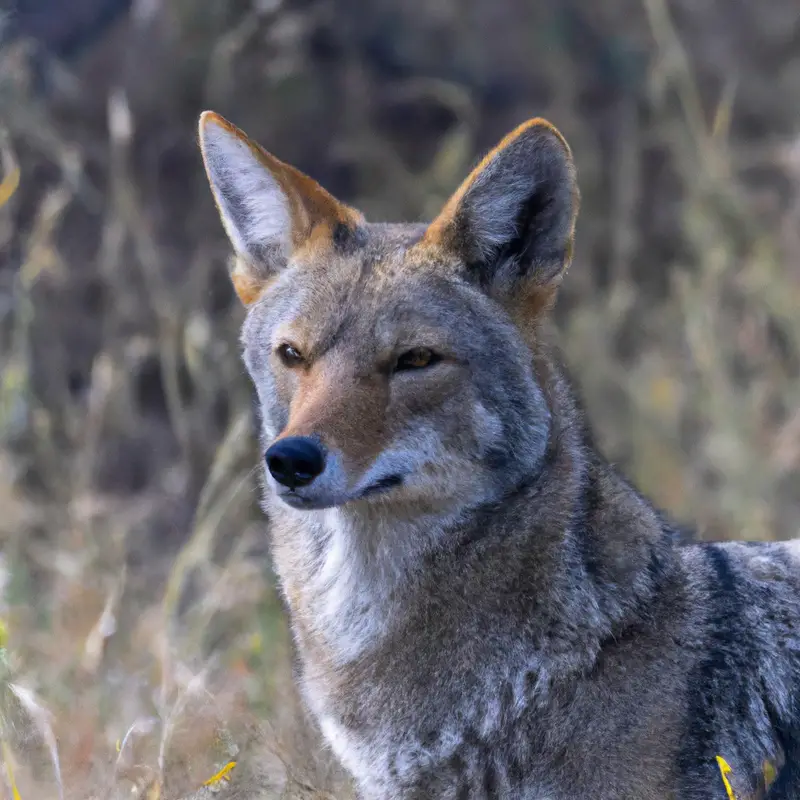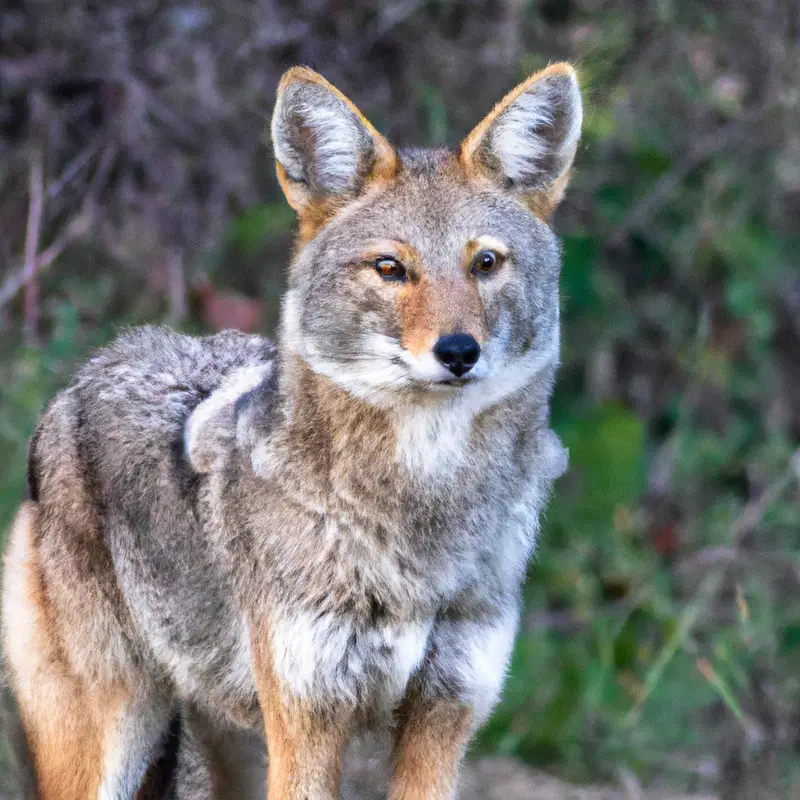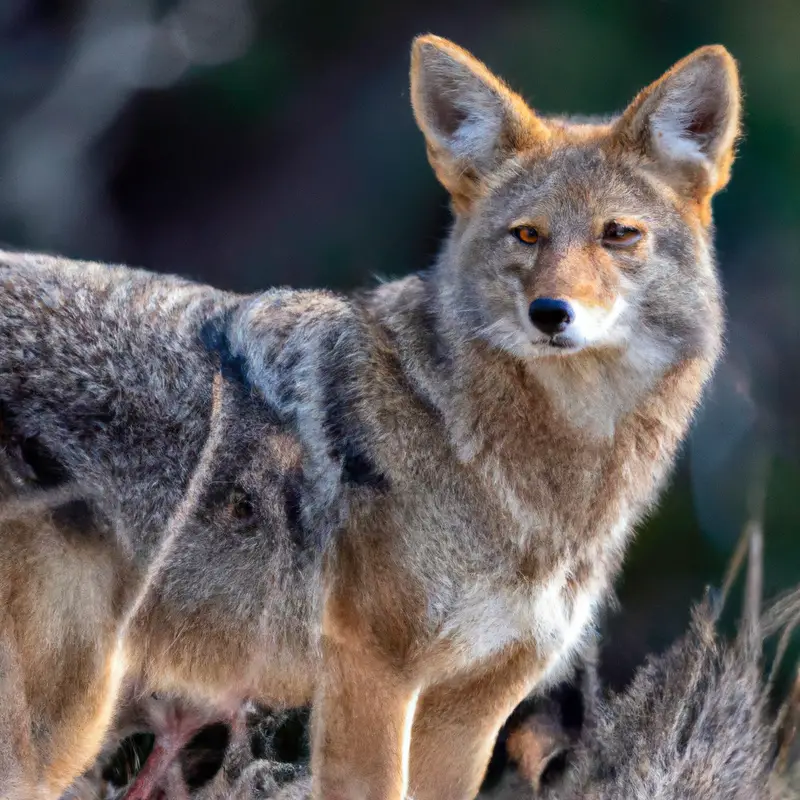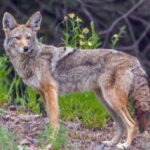Key Takeaways:
- Coyote hunting is legal in Arkansas and requires a hunting license.
- Arkansas has no specific season or bag limits for coyote hunting.
- Hunters are encouraged to take appropriate safety measures and be aware of private lands.
- Using electronic calls or decoys is allowed when hunting coyotes in Arkansas.
Have you ever experienced the thrill of hunting coyotes?
If not, let me take you on an exciting journey to the wild terrains of Arkansas, where the coyote population thrives.
As an expert on coyote hunting in Arkansas, I’ve explored the ins and outs of this exhilarating sport.
In this article, I’ll provide a comprehensive overview of hunting regulations, the best time to hunt, various hunting methods, essential equipment and gear, and expert tips to increase your chances of success.
Get ready to embark on an adventure like no other as we dive into the world of coyote hunting in Arkansas!
Hunting Coyote in Arkansas | |
|---|---|
Pros | Cons |
– Helps control the coyote population and reduce damage to livestock – Hunting coyotes can be a challenging and exciting sport – It promotes wildlife conservation by managing predator populations | – Requires knowledge of hunting regulations and obtaining the necessary licenses – Can be dangerous, as firearms are involved – May require additional time, effort, and investment in hunting equipment |
Overview of Coyote Hunting in Arkansas
Hunting Regulations in Arkansas
When hunting coyote in Arkansas, it’s important to be aware of the hunting regulations. Here are the key points you need to know:
- Hunting Season: Coyote hunting is open year-round in Arkansas, with no specific season restrictions. This means you have the flexibility to hunt these animals whenever it suits you.
- Weapons and Ammunition: You are allowed to use any legal weapon for hunting coyote in Arkansas. This includes rifles, shotguns, pistols, and archery equipment. Ensure that you are using legal ammunition as well.
- Licenses and Permits: To hunt coyote in Arkansas, you will need a valid hunting license. If you are a non-resident, you may need a non-resident hunting license. It’s always best to check with the Arkansas Game and Fish Commission for the most up-to-date regulations.
- Hunting Methods: There are no specific restrictions on hunting methods for coyote in Arkansas. You can use spotlights, electronic calls, and decoys to attract the animals. However, make sure you are following all safety guidelines.
Remember to always practice ethical hunting, respect private property rights, and follow additional rules and regulations established by the Arkansas Game and Fish Commission. By adhering to these regulations, you can enjoy a safe and rewarding coyote hunting experience in Arkansas.
Best Time to Hunt Coyotes in Arkansas
The best time to hunt coyotes in Arkansas is during the early morning and late evening hours.
coyotes are most active during these times, when they are searching for food.
It’s also important to consider the weather conditions when planning your hunt.
Coyotes are more active on cooler days, so hunting during fall and winter months can be particularly effective.
Keep in mind that hunting coyotes requires a hunting license and knowledge of local hunting regulations.
Always prioritize safety and be sure to follow all the rules and regulations set by the Arkansas Game and Fish Commission.
Happy hunting!

Hunting Methods for Coyotes in Arkansas
In Arkansas, there are various methods for hunting coyotes. Here are a few:
- Calling: Using electronic or mouth calls to mimic prey distress or coyote vocalizations to attract them.
- Spot and Stalk: Locating coyotes through scouting and then stealthily approaching them for a shot.
- Using Decoys: Placing decoys to lure coyotes into range, often in combination with calling.
- Hunting with Dogs: Some hunters use trained dogs to track and corner coyotes, making it easier to take a shot.
- Night Hunting: Allowed in certain areas, using specialized equipment such as night vision scopes or thermal imaging to locate and shoot coyotes after dark.
Each method has its own set of strategies and challenges, so it’s essential to research and understand the regulations and best practices before heading out. Happy hunting!

Equipment and Gear for Coyote Hunting in Arkansas
When you’re heading out for coyote hunting in Arkansas, there are a few pieces of equipment and gear that you’ll need to have a successful hunt. Here are the essentials:
- Firearms: A high-powered rifle chambered in .223 or .243 is recommended for coyote hunting. Make sure you’re familiar with your weapon and practice your aim before hitting the field.
- Optics: Invest in a quality scope or binoculars to help you spot coyotes from a distance. A clear and accurate view will greatly improve your chances of success.
- Calls: Coyote calls are a crucial tool for luring in these wily creatures. A variety of calls mimic different distress sounds, which can attract coyotes and bring them within range.
- Decoys: Using decoys can be an effective strategy for drawing in curious coyotes. Look for realistic decoys that mimic injured prey animals, as they can help create a more natural hunting environment.
- Camouflage: Blend in with your surroundings by wearing camouflaged clothing and using natural cover to conceal yourself. Coyotes have keen eyesight, so staying hidden is essential.
- Game bags: Once you’ve successfully bagged a coyote, you’ll want to have a game bag or something similar to transport the animal. This will help keep the carcass clean and prevent spoilage.
Remember, always check the regulations in Arkansas regarding hunting licenses, tags, and any specific gear requirements before heading out. Happy hunting!
Essential Tips for Coyote Hunting in Arkansas
Here are some essential tips for hunting coyotes in Arkansas:
- Know the hunting regulations: Familiarize yourself with the specific rules and regulations for coyote hunting in Arkansas to ensure you are hunting within the law.
- Scout the area: Spend time in the field to locate areas frequented by coyotes. Look for signs such as tracks, scat, and prey remains.
- Use predator calls: Coyotes are attracted to distress calls of small animals. Experiment with different calls to find what works best in your hunting area.
- Be patient and silent: Set up in a concealed location and wait quietly for coyotes to approach. Patience is key as coyotes might take time to respond.
- Opt for camouflage: Wear appropriate camouflage clothing to blend in with the surroundings and avoid being detected by sharp-eyed coyotes.
- Practice your shot: Make sure you can confidently shoot accurately at various distances. This will increase your chances of success when a coyote finally comes into view.
- Consider using decoys: Using decoys can help attract coyotes and draw them closer for a better shot opportunity. Experiment with different decoys to find what works best.
- Stay safe: Always prioritize safety while hunting. Be aware of your surroundings, know where other hunters are, and never shoot unless you have a clear and safe shot.
Remember, successful coyote hunting takes practice and experience. Stay persistent and adapt your strategies as needed for the best results in Arkansas.

Coyote Hunting Techniques
Calling Techniques for Coyote Hunting in Arkansas
Calling techniques are essential for successful coyote hunting in Arkansas.
Start with a locator call to elicit a response from a coyote.
Once you’ve received a response, switch to a distress call, imitating the sound of prey in danger.
Vary the pitch, duration, and intensity of your calling to simulate an authentic distress situation.
Additionally, using electronic calls or mouth calls can be effective.
Experiment with different calls and find out what works best in your hunting area.
It’s important to remember that coyotes have keen hearing, so be patient and persistent in your calling efforts.
Spot and Stalk Method for Coyote Hunting in Arkansas
If you’re interested in coyote hunting in Arkansas, the spot and stalk method is a common technique that can be effective.
This method involves spotting a coyote from a distance and then quietly stalking it until you’re within range for a shot.
Here are some tips for using the spot and stalk method in Arkansas:
- Scout the area beforehand to familiarize yourself with coyote habits and potential hunting spots.
- Use binoculars or a spotting scope to locate coyotes from a safe distance.
- Move slowly and quietly, staying low to the ground and using available cover to stay hidden.
- Take advantage of natural features like hills and vegetation to get closer to the coyote without being seen.
- Be patient and wait for the right moment to take your shot, ensuring a clean and ethical kill.
Remember to always follow local hunting regulations and obtain any necessary permits before hunting coyotes in Arkansas.
Good luck!
Nighttime Hunting for Coyotes in Arkansas
Nighttime hunting for coyotes in Arkansas can be an effective strategy to manage their population.
When hunting at night, it is important to use appropriate equipment such as night vision scopes or thermal imaging devices to enhance visibility.
Additionally, using predator calls can attract coyotes and increase your chances of a successful hunt.
Remember to always follow local regulations and obtain the necessary licenses and permits.
Stay safe and happy hunting!
Setting Up Natural Attractants for Coyote Hunting in Arkansas
Setting up natural attractants for coyote hunting in Arkansas can greatly increase your chances of success.
One effective method is to use predator urine, such as coyote or fox urine, to create a scent trail that will draw the coyotes in.
Additionally, using a distress call or howler can mimic the sounds of injured prey, piquing the curiosity of nearby coyotes.
Grooming a specific area to create a mock kill site can further entice coyotes to investigate.
Finally, using natural cover, such as brush or vegetation, to conceal your presence can help you stay hidden from the keen eyes of these elusive predators.
Safety Precautions and Legal Considerations
Safety Tips for Coyote Hunting in Arkansas
When hunting coyotes in Arkansas, it’s important to prioritize safety.
Here are some tips to keep in mind:
- Always wear bright, visible clothing to help prevent accidental shootings.
- Use a reliable firearm or bow that you are comfortable handling.
- Familiarize yourself with the hunting regulations and seasons in Arkansas.
- Obtain the necessary licenses and permits required for coyote hunting.
- Be aware of your surroundings and never shoot at unidentified targets.
- Consider hunting with a partner for added safety and support.
- Practice responsible firearm handling and always keep your muzzle pointed in a safe direction.
- Remember to bring essential safety gear like a first aid kit and a means of communication in case of emergencies.
- Respect private property and seek permission from landowners before hunting on their property.
- Finally, share your hunting plans with someone trustworthy, so they know where you’ll be in case of any unforeseen circumstances.
Key Hunting Laws and Regulations in Arkansas
In Arkansas, it’s important to be aware of the key hunting laws and regulations to ensure a safe and legal hunting experience. Here are some important points to keep in mind:
- Hunting License: You must have a valid hunting license to hunt in Arkansas. Make sure to obtain the appropriate license for the game you wish to hunt.
- Season and Bag Limits: Each species has specific hunting seasons and bag limits. It’s crucial to know these regulations to avoid any violations.
- Hunter Education: If you were born after 1968, you must complete a hunter education course before obtaining a hunting license in Arkansas.
- Private Land Permission: Don’t forget to secure permission from the landowner before hunting on private property. It’s always good practice to ask for permission and respect the landowner’s rules.
- Legal Hunting Methods: Familiarize yourself with the legal hunting methods allowed in Arkansas, such as firearms, archery equipment, or crossbows. Some areas may have specific restrictions, so check local regulations.
- Game Tagging and Reporting: After harvesting a game animal, you must properly tag it and report your harvest within 24 hours through the Arkansas Game Check system.
- Safety Precautions: Practice firearm safety, use proper hunting gear, and always be aware of your surroundings. It’s essential to prioritize safety both for yourself and others.
Remember, these are just some of the key laws and regulations in Arkansas. It’s important to carefully review and comply with all applicable hunting laws to have a legal and responsible hunting experience.
Permission and Licensing Requirements for Coyote Hunting in Arkansas
To hunt coyotes in Arkansas, you’ll need a valid hunting license, as well as permission from the landowner if you plan to hunt on private property. The Arkansas Game and Fish Commission (AGFC) issues hunting licenses, and you can purchase them online or at authorized retailers.
Additionally, the AGFC may have specific regulations or restrictions on coyote hunting, so it’s essential to review these before heading out.
Remember, always follow hunting safety guidelines and practice ethical hunting techniques. Happy hunting!
Hunting Locations in Arkansas
Public Land for Coyote Hunting in Arkansas
There are several public lands in Arkansas where you can go coyote hunting. Some popular options include the Ozark National Forest, the St. Francis National Forest, and the White River National Wildlife Refuge.
These areas offer ample opportunities to spot and track coyotes.
Additionally, you can check with the Arkansas Game and Fish Commission for specific regulations and guidelines regarding hunting coyotes on public land in the state. Remember to always obtain the necessary permits and licenses before heading out.
Happy hunting!
Private Land Opportunities for Coyote Hunting in Arkansas
If you’re looking for private land opportunities for coyote hunting in Arkansas, you’re in luck. There are numerous landowners in the state who allow hunting on their property.
Many of them offer guided hunts or lease their land to hunting clubs.
It’s important to reach out to these landowners and establish a good rapport. By respecting their property and following their rules, you’ll have a better chance of gaining access to private land for your coyote hunting adventures.
Remember, building relationships with landowners is key to securing private hunting opportunities.
Wildlife Management Areas for Coyote Hunting in Arkansas
There are several wildlife management areas in Arkansas where you can go coyote hunting. These areas are specifically designated for wildlife management and conservation.
Some popular wildlife management areas for coyote hunting in Arkansas include Bayou Meto WMA, Dave Donaldson Black River WMA, and Trusten Holder WMA.
It’s important to check the specific regulations and requirements for each area, including any hunting permits and restrictions. Always remember to follow ethical hunting practices and prioritize safety during your hunting trips.
Coyote Hunting Tips and Strategies
Tracking and Scouting Techniques for Coyote Hunting in Arkansas
When it comes to tracking and scouting techniques for coyote hunting in Arkansas, there are a few key strategies to keep in mind.
- Start by scouting the area during daylight hours to familiarize yourself with coyote signs, such as tracks and scat.
- Look for areas with abundant food sources, like deer or rabbit populations, as coyotes tend to hunt where prey is plentiful.
- Utilize trail cameras to monitor coyote activity and to identify their travel patterns and preferred routes.
- When tracking, pay close attention to wind direction to prevent your scent from alerting coyotes to your presence.
By implementing these tracking and scouting techniques, you can increase your chances of successful coyote hunting in Arkansas.
Camouflage and Concealment Methods for Coyote Hunting in Arkansas
When hunting coyotes in Arkansas, camouflage and concealment are key in increasing your chances of success. Here are some effective methods to consider:
- Choose the right camouflage: Select camouflage patterns that closely match the natural surroundings in your hunting area, such as forest or brush patterns. This will help you blend in and remain undetected by coyotes.
- Break up your silhouette: Avoid standing out by using natural cover like trees, bushes, or grass to break up your outline. This will make it harder for coyotes to spot you.
- Use natural cover scents: Mask your human scent by using natural cover scents like earth or foliage. This can help hide your presence and prevent coyotes from sensing something is off.
- Stay still and use concealment: Find a concealed location where you can hide and wait for coyotes to approach. Utilize blinds, natural ground cover, or tree stands to conceal your position.
- Move slowly and cautiously: When stalking coyotes, move slowly and carefully to avoid alarming them. Make sure to watch your footing and minimize noise to remain undetected.
Remember, when it comes to coyote hunting in Arkansas, effective camouflage and concealment techniques can greatly improve your chances of a successful hunt.
Decoying for Coyote Hunting in Arkansas
Decoying can be an effective strategy for coyote hunting in Arkansas. Using decoys that mimic distressed prey or other coyotes can attract curious coyotes to your location.
Place the decoy in a visible spot, set up downwind, and hide yourself well.
Use distress calls or coyote vocalizations to add to the realistic effect. Remember to stay patient and still, as coyotes may take some time to approach the decoy.
Effective Shot Placement for Coyote Hunting in Arkansas
When it comes to effective shot placement for coyote hunting in Arkansas, there are a few key factors to keep in mind. Firstly, aiming for the vital organs, such as the heart and lungs, is crucial to ensure a quick and ethical kill.
Secondly, understanding the anatomy of a coyote is important, aiming for the chest area just behind the shoulder is your best bet.
Thirdly, consider shooting from a stable position, such as using a bipod or shooting sticks, to increase accuracy and minimize the chance of wounding the animal. Finally, practice your marksmanship skills regularly to improve your accuracy and ensure clean, ethical shots.
Happy hunting!
Frequently Asked Questions (FAQs) about Coyote Hunting in Arkansas
Can I hunt coyotes year-round in Arkansas?
Yes, you can hunt coyotes year-round in Arkansas. There are no specific seasons or restrictions on coyote hunting in the state.
This means you have the freedom to pursue coyotes whenever you like, as long as you adhere to the general hunting regulations and guidelines set by the Arkansas Game and Fish Commission.
Remember to always practice ethical hunting and prioritize safety while enjoying your coyote hunting adventures in Arkansas.
What firearms are allowed for coyote hunting in Arkansas?
In Arkansas, for coyote hunting, you are allowed to use various firearms. These include shotguns, rifles, and handguns.
Shotguns chambered in 10 gauge, 12 gauge, 16 gauge, or 20 gauge can be used, with slugs or buckshot.
For rifles, the minimum caliber required is .22 centerfire, and semiautomatic rifles are allowed. Handguns chambered in .22 caliber or larger can also be used.
However, it’s always a good idea to check with the Arkansas Game and Fish Commission for any specific regulations or restrictions before heading out for your hunt.
Are electronic calls allowed for coyote hunting in Arkansas?
Yes, electronic calls are allowed for coyote hunting in Arkansas. Hunters are permitted to use electronic calls to attract coyotes during hunting seasons.
This means you can use electronic devices that mimic the sounds of injured prey or other coyote vocalizations to lure coyotes to your hunting location.
It’s important to check any specific restrictions or regulations from the Arkansas Game and Fish Commission before heading out on your hunt. So feel free to use electronic calls to increase your chances of a successful coyote hunt in Arkansas!
Can I use night vision or thermal scopes for coyote hunting in Arkansas?
You are allowed to use night vision and thermal scopes for coyote hunting in Arkansas.
These devices can greatly enhance your hunting experience, especially during low-light conditions.
With night vision, you can see in the dark by amplifying available light, while thermal scopes detect heat signatures, making it easier to spot coyotes.
However, it is important to familiarize yourself with the relevant state laws and regulations regarding the use of these scopes, as they may have certain restrictions or requirements.
Always prioritize safety and ethical hunting practices.
Do I need to report my coyote harvest in Arkansas?
Yes, you are required to report your coyote harvest in Arkansas.
Arkansas law states that any furbearer, including coyotes, must be reported within 24 hours of harvest.
Reporting can be done online or by phone, and it helps the state track population numbers and manage wildlife resources effectively.
It is important to follow these reporting regulations to ensure the proper management of coyote populations and the conservation of wildlife in Arkansas.
Are there any restrictions on hunting coyotes near residential areas in Arkansas?
Yes, there are restrictions on hunting coyotes near residential areas in Arkansas. The Arkansas Game and Fish Commission (AGFC) prohibits the discharge of firearms within city limits and within 1,000 feet of a residence or occupied building without the owner’s consent.
This means that you need permission from the property owner to hunt coyotes near residential areas.
It’s important to be mindful of these restrictions to ensure the safety of residents and comply with state regulations.
Final Verdict
Coyote hunting in Arkansas offers a thrilling and challenging experience for hunters. By understanding the hunting regulations, best hunting times, and various hunting methods, hunters can increase their chances of success.
Safety precautions and legal considerations should always be prioritized, and obtaining the necessary permissions and licenses is crucial.
Arkansas provides both public and private land opportunities for hunting, and proper tracking, scouting, and camouflage techniques can greatly enhance the hunting experience. Overall, coyote hunting in Arkansas requires knowledge, skill, and patience, but with the right strategies and equipment, it can be a rewarding and exhilarating endeavor.









